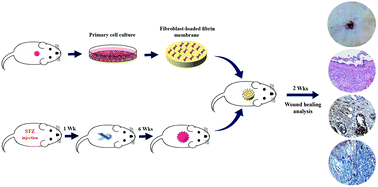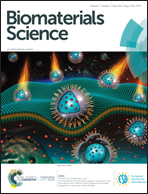A fibrinous and allogeneic fibroblast-enriched membrane as a biocompatible material can improve diabetic wound healing
Abstract
The application of conventional approaches to diabetic wound regeneration has some limitations. Thus, skin substitutes could be a new therapeutic possibility. In this regard, fibrin scaffolds are promising materials due to their desirable characteristics. Since defective fibroblasts caused by diabetes can disrupt regeneration, it seems that the use of living cells can improve the healing process. Thus, based on this fact, a cellular fibrin membrane was used to evaluate the diabetic wound healing in rats. The fibrin membrane was fabricated using fresh frozen plasma on which isolated fibroblasts were cultured. The wound model was created on 36 diabetic rats that were randomly divided into three groups: control, membrane, and cellular fibrin membrane (CM). Wound photogramography and immuno-histopathological staining were performed during consecutive days after treatment. Macroscopic evaluation of the wounds indicated a noteworthy enhancement of wound closure in the CM group. In the CM group, the re-epithelialization rate on day 7, 10 (p < 0.001), and 14 (p < 0.05), the fibroblast percentage on day 3 (p < 0.01) and 7 (p < 0.05) and the collagenization in all days were significantly higher than those of other groups (p < 0.001). The fibroblast number in the CM group on day 10 was significantly (p < 0.01) lower than that in the other groups. Contrary to the neutrophil and angiogenesis percentages that had no significant difference among the groups at different points of time (p > 0.05), the macrophage percentage on day 7 (P < 0.01), 10, and 14 (p < 0.05) was significantly lower in the CM group as compared to that in other groups. Overall, it seems that the use of a fibroblast-loaded fibrin membrane is an attractive strategy to promote diabetic wound healing.



 Please wait while we load your content...
Please wait while we load your content...